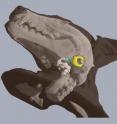Bat researchers no longer flying blind on echolocation
Researchers at The University of Western Ontario (Western) led an international and multi-disciplinary study that sheds new light on the way that bats echolocate. With echolocation, animals emit sounds and then listen to the reflected echoes of those sounds to form images of their surroundings in their brains. The team used state-of-the-art micro-computed tomography systems at the Robarts Research Institute in London, Ontario to collect detailed 3D scans of the internal anatomy of 26 different bats, representing 11 different evolutionary lineages. This non-destructive technique allowed researchers to identify a bone that connects the larynx to the bones that surround and support the eardrum in bats. Some bats use their larynx to generate echolocation (biosonar) signals, allowing them to operate at night; other bats use tongue clicks to achieve the same purpose.
The research team discovered that the connection between the larynx and the ear via the stylohyal bone in the hyoid chain was unique to bats that used laryngeal echolocation. This observation makes it possible to distinguish bats that produce echolocation signals with their larynx from bats that do not echolocate and those that use tongue clicks. The results of the research will appear this week in the journal Nature, entitled "A Bony Connection Signals Laryngeal Echolocation in Bats".
The discovery adds new information to the ongoing debate about the timing and origin of flight and echolocation in the early evolution of bats. "This discovery may change the way that researchers interpret previous observations from the fossil record of bats," says Brock Fenton, the Western biologist who led the study. "These new results give researchers working with fresh or fossil material an independent anatomical characteristic to distinguish laryngeally-echolocating bats from all other bats."
The investigation was made possible because of a unique multi-disciplinary and international collaboration between imaging scientists, biophysicists, biologists, physiologists, and neuroscientists at five different institutions. "The micro-imaging equipment used in this study was developed in London, Ontario for use in medical research," says Robarts' imaging scientist David Holdsworth, "but it was very exciting to see it used so effectively in basic biological research."
3D micro-imaging allowed the team to investigate the internal anatomy of a diverse collection of bat specimens that were provided by Judith Eger, senior curator of mammalogy at the Royal Ontario Museum.
Students played a major role in the study, highlighting the important link between teaching and research. The joint first authors, Nina Veselka and David McErlain, are both Western students; co-author Kirsty Brain is a student at the University of Cambridge.
The original idea for the innovative study came from a radiologist, Dr. Rethy Chhem, who brought together biologists and imaging scientists at Western to apply non-destructive imaging to a basic biological research question. Scientists Matthew Mason at the University of Cambridge and Paul Faure at McMaster University provided the additional expertise in mammalian physiology and neurobiology needed to carry out the research. "This work is an important step forward in echolocation research because for years, scientists have been searching for a mechanism that would allow echolocating animals to a have a neural representation of their outgoing biosonar sounds for future comparison with reflected echoes of the sounds, and this anatomical discovery may be that mechanism," says Faure.
The small-animal micro-CT used in the study also has implications for clinicians and biophysicists working with animal models to identify and correct hearing impairments in humans. The results reported in the Nature article also are important because they emphasize the value of detailed, 3D computerized analysis of extensive existing animal museum collections. In the future, this type of "virtual dissection" could be used to study the micro-anatomy of many other species of small animals or insects. The resulting three-dimensional computer display of internal structures is likely to lead to the next generation of "virtual museum" or "online museum", where researchers can study internal anatomy remotely and without dissecting the specimen. Additional non-destructive micro-CT studies of bat anatomy are already underway at Western, including detailed studies of the larynx and cochlea.
